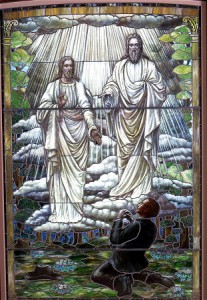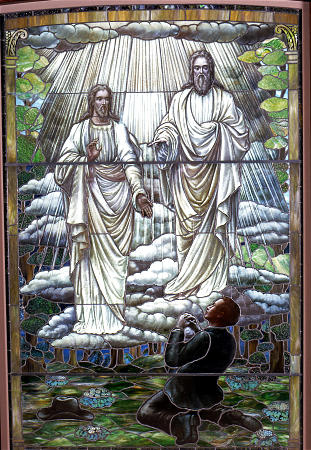In 1811, the Smith family moved to West Lebanon, New Hampshire. At this time Lucy Mack Smith, Joseph Smith’s mother, remarked that they settled and “began to contemplate, with joy and satisfaction, the prosperity which had attended our recent exertions; and we doubled our diligence, in order to obtain more of this world’s goods, with the view of assisting our children when they should need it.” At this time none of their children had had much schooling, and so they set about making arrangements for all their children to do so. Soon thereafter, typhus fever struck Lebanon and killed 6,000 people. All of the Smith children were taken ill, and their daughter Sophronia nearly died.
 Lucy and Joseph Smith, Sr., spent nearly all their savings on medical care for their affected children. Joseph was ill for two weeks, but after recovering from the fever developed a serious infection in his shoulder. It struck him forcefully one day, and he cried out in such pain that they immediately sent for the doctor. The doctor concluded the pain must have come from a sprain, but Joseph knew he had done nothing that would make that possible. The doctor anointed Joseph’s shoulder with some bone liniment, but to no affect.
Lucy and Joseph Smith, Sr., spent nearly all their savings on medical care for their affected children. Joseph was ill for two weeks, but after recovering from the fever developed a serious infection in his shoulder. It struck him forcefully one day, and he cried out in such pain that they immediately sent for the doctor. The doctor concluded the pain must have come from a sprain, but Joseph knew he had done nothing that would make that possible. The doctor anointed Joseph’s shoulder with some bone liniment, but to no affect.
Lucy gives a detailed description of the events that transpired:
“When two weeks of extreme suffering had elapsed, the attendant physician concluded to make closer examination, whereupon he found that a large fever sore had gathered between his breast and shoulder. He immediately lanced it, upon which it discharged fully a quart of matter.
“As soon as the sore had discharged itself the pain left it, and shot like lightning (using his own terms) down his side into the marrow of the bone of his leg and soon became very severe. My poor boy, at this, was almost in despair, and he cried out ‘Oh father! the pain is so severe, how can I bear it!’
“His leg soon began to swell and he continued to suffer the greatest agony for the space of two weeks longer. . . .
“At the end of three weeks, we thought it advisable to send again for the surgeon. When he came he made an incision of eight inches, on the front side of the leg, between the knee and ankle. This relieved the pain in a great measure, and the patient was quite comfortable until the wound began to heal, when the pain became as violent as ever.”
The wound was cut a second time, but with the same result, and then the bone became infected. Doctors told Lucy they would have to amputate, but Lucy refused to let them until they had tried one more time to operate on the bone. This they did successfully, though at great pain to Joseph, who refused any alcohol as an anesthetic. Full recovery took about three years, but Joseph was able to keep his leg. After these incidents, however, the Smith family savings had been entirely used. Lucy said, “When health returned to us, as one would naturally suppose, it found us in quite low circumstances. We were compelled to strain every energy to provide for our present necessities, instead of making arrangements for the future, as we had previously contemplated.” Thus their children were not able to attend as much school as they had hoped to, and the family was not financially prepared for the calamity that struck soon after.
While Joseph was still healing the family moved to Norwich, Vermont, in 1813. The Smiths worked a farm on the property of Esquire Murdock. The first two years the family spent in Norwich their crops failed. The first year they were able to sell enough fruit to get by, but the second year was the same. Joseph Smith, Sr., decided he would try to plant one more year, and if the crops failed again, they would go to New York and raise wheat. The third year, however—1816—proved to be the worst of all. Known as the year without a summer, or as “eighteen hundred and froze to death,” a short spring came, but was replaced by more winter-like weather, with four successive frosts between June and August that killed nearly all the crops in the state.
The bizarre weather conditions, it was discovered much later, were due to an enormous volcanic eruption on the other side of the world. Mount Tambora, in Indonesia, exploded in the largest volcanic eruption in recorded history, emptying twenty-five cubic miles of debris into the atmosphere. The ash covered the sun and travelled thousands of miles, affecting the weather pattern for an extended period. Many people left Vermont in a mass exodus, looking for more fertile ground. The Smiths also moved. However, two such catastrophic events crippled the family financially and they had to work extremely hard and go into much debt in order to survive.
Twitter •


 Watch a video about the restoration of the gospel on lds.org
Watch a video about the restoration of the gospel on lds.org